Santa Fe New Mexico, “The City Different“, can claim many unique attributes. For one thing Santa Fe’s 7,000 foot elevation makes it the highest state capitol in the United States. Santa Fe can also lay claim to being the oldest city in the U.S. being founded by the Spaniard Conquistadors in 1610.
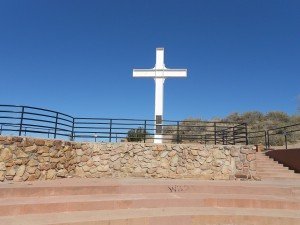
The Spaniards remained in control of this region up until the Mexican’s rebelled in the 1820’s, with the exception of the period of the Pueblo Revolt beginning in 1680 that expelled the Spaniards from the territory for some twelve years.
The Cross of the Martyrs pictured at left is in memory of those lost during the Pueblo Revolt.
Santa Fe New Mexico
Santa Fe evolved from being a rather sleepy southwest trading center to a modern day tourist destination of international acclaim. The way in which this occurred is a very interesting story. It’s a story that interweaves the opening of the west with the expansion of the transcontinental railroads. The Santa Fe Railroad, the Atchison Topeka & Santa Fe, promoted both Santa Fe and the southwest culture.
Santa Fe’s prominence in the earlier part of the 1800’s was the fact that it was the final destination of the famed and important Santa Fe Trail. The trail that ran from Missouri through the Great Plains then into mountainous New Mexico was the first real commercial trade route between the U.S. and Mexican ruled New Mexico.
Trading on the Santa Fe Trail
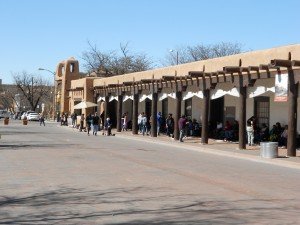
There was a great deal of trade going on between American’s and New Mexican’s prior to the breakout of the Mexican-American War. This was how northern New Mexicans received supplies that they couldn’t get elsewhere. It was a much easier trade route than having to rely on supplies from the very distant Mexico City government.
The United States Takes Control
The United States took control of New Mexico during the 1846 Mexican-American War and named it a U.S. Territory after the war,s end. General Kearney’s troops took over Santa Fe and New Mexico without firing a shot and the tale is that Kearney stayed in the inn which was then at the very site of today’s La Fonda Hotel on the plaza. The hotel was renamed the United States Hotel.
The territory’s capitol was Santa Fe and this new Union territory was vast in size. Essentially it comprised all of present day New Mexico and Arizona. The principle trade route to the new Union territory remained the Santa Fe Trail.
In Comes the Santa Fe Railroad
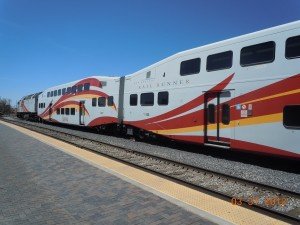
In the coming years the railroad would be the engine of growth, not only for the New Mexico Territory but for the entire western U.S. in general.
Because of the railroad’s place in economic expansion, railroads had a tremendous amount of power and influence. What better industry was there to not only transport people to the west but also to urge them to make the journey. The railroad also offered the first “comfortable” way to travel west. There were stagecoaches long before the transcontinental railroad but people traveling long distances by stagecoach did it out of necessity rather than by choice. If you read any pieces about the rigors of long distance stage travel you’ll understand what I mean. Stagecoach travel was not only less comfortable than by rail but the stagecoach was more susceptible to highwaymen (bandits).
The Atchison Topeka and Santa Fe Railroad
The Atchison Topeka & Santa Fe Railroad was in a position to promote the beautiful southwest. The geologic formations in the American southwest are truly unique as are the cultural characteristics of a town like Santa Fe.
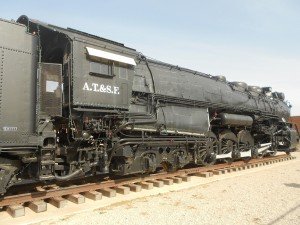
While Santa Fe did not lie directly on the AT&SF rail main line, and is connected to it by an 18 mile spur line, the railroad’s namesake town was the most publicized AT&SF destination by far.
The AT&SF of course was integral in the promotion of the Grand Canyon with not only it’s link from Williams Arizona via the Grand Canyon Railroad but also it’s building of the El Tovar Hotel at the Canyon’s south rim. The El Tovar was managed by Fred Harvey who had a very successful association with the railroad.
Fred Harvey has often been credited with helping to civilize the west. Interestingly enough, the southwest including Santa Fe had originally been advertised back east for it’s health benefits. Prior to it’s emphasis on Native American art and culture, the area was thought to be quite beneficial for tuberculosis patients (called consumption during the era). This was the subject of AT&SF’s first promotion of Santa Fe. The dry mild weather and the high elevations were considered to be a relief, if not a remedy, for consumptive sufferers. Both Santa Fe and Albuquerque and much of the southwest were destinations for people afflicted with the malady.
Promoting Santa Fe the Atchison Topeka & Santa Fe Way
The powerful and inventive combination of the AT&SF and Fred Harvey worked magic in the promotion of Santa Fe. While the Santa Fe railroad had it’s line into New Mexico decades before, the turning point for it’s promotion of Santa Fe began in 1925 when it purchased the La Fonda Hotel.
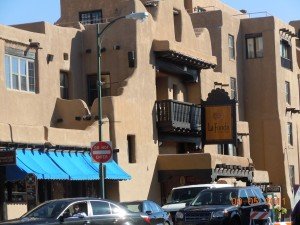
The La Fonda was unique, being situated at the very end of the famed Santa Fe Trail and also immediately adjacent to the Santa Fe plaza. The site had been operated as an inn for many decades under various names and ownership. At one point in the early 1900’s it had been destroyed by fire and then rebuilt by local investors. The hotel’s expansion and promotion however took off when the railroad bought the hotel in 1925.
At that time rooms were added and the Fred Harvey Company applied it’s expertise of quality hospitality. Nobody did more than Fred Harvey to standardize the quality of westward travel. Harvey’s expertise had it’s roots when he traveled extensively as a railroad freight agent and had the experience of sampling the less than terrific dining fare along the rail lines. He saw a great need for better quality and filled it. His association with the AT&SF gave him the resources to make his ideas a reality. He put his ideas to work all along the railroad’s line and eventually far beyond with his many Harvey House Hotels.
The Santa Fe Railroad, AT&SF, can rightfully be credited with making Santa Fe the tourist mecca that it is today. It was the railroad’s access to the town which spurred the arrival of artists. Many credit the railroad for the initial building of Santa Fe’s art community.
 The railroad went as far as commissioning several artists to put the regions natural beauty on canvas and these paintings adorned the AT&SF stations all along the line.
The railroad went as far as commissioning several artists to put the regions natural beauty on canvas and these paintings adorned the AT&SF stations all along the line.
Brochures and news articles were disseminated by the AT&SF advertising department to great effect. This was powerful advertising for Santa Fe and it worked. The railroad drew on the areas natural attributes of a multicultural society. Native American, Spanish and Mexican cultures all combined to promote Santa Fe as “The City Different“.
The railroad and Fred Harvey also operated “Indian detour” as a motorcar tour of both Santa Fe and the surrounding pueblos. The “Indian detour” guides were selectively chosen and were quite knowledgeable. Evening lectures by “Indian detour” guides at the La Fonda were customary. Many of Santa Fe’s early tourists had only read about the region through eastern newspaper accounts and now the AT & SF Railroad and Fred Harvey offered a comfortable and highly interesting way to travel there and see the sights first hand. The railroad tapped into the curiosity of easterners.
Four additional articles we’ve published that you’ll find interesting include.
The Union Pacific Big Boy Locomotive
Barrio de Analco and America’s Oldest House
Fiesta Santa Fe
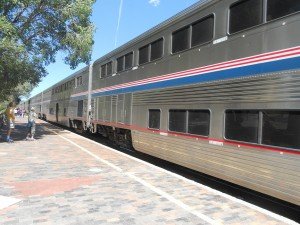
The railroad didn’t stop with the “Indian detour” motorcar tours. They also became involved in promoting cultural events themselves. One of these, and arguably the largest, was the “Fiesta“.
The Fiesta was first held in 1712 and was meant to commemorate the 1692 peaceful resettlement of the area by the Spaniard De Vargas. The year 1692 was when De Vargas led his Spaniards back to Santa Fe twelve years after the 1680 Pueblo Revolt.
After 1712 the Fiesta was held only every so often and eventually disappeared all together. Fast forward and the Fiesta was revived in 1919 by the efforts of Edgar L. Hewett, the Director of the Museum of New Mexico. The power of AT&SF marketing promoted the revival of Fiesta to the traveling public and the event remains today Santa Fe’s most popular.
Out of the three cultural segments making up Santa Fe, the railroad placed major emphasis on the Native American aspect. The southwest’s and particularly Santa Fe’s pueblo residing Native American’s were the main subject matter of AT&SF advertising. Native American’s sold their unique artistic jewelry in the lobby of the railroad’s La Fonda Hotel. The railroad turned pueblo Indian artistry into a profitable commercial venture.
It was said that prior to the railroad bringing in willing buyers, many Indians lacked the necessary tools to create their crafts. The sales to the AT&SF transported tourists helped the Indians buy the tools they needed to produce more authentic pieces. The market for authentic Native American crafts is still very evident today when you see genuine Native American items being sold in many stores on the plaza and daily in front of the Palace of the Governors on the north side of the plaza.

The Lasting Effect of the AT&SF
Santa Fe through all the years has sustained it’s position as a highly popular tourist destination in large part from the early promotion efforts of the AT&SF Railroad. The railroad laid down a lasting foundation.
Many of the descriptions of Santa Fe in early railroad advertising brochures made it into books authored by Zane Grey and Charles Lummis, two well known writers of the American southwest. Santa Fe’s historical authenticity continues to draw tourists by the thousands. While people today travel to Santa Fe by automobile, airplane and certainly still by rail (Amtrak’s Southwest Chief), the modern perception of Santa Fe can be traced directly back to the AT&SF Railroad’s promotional campaigns of the early 1900’s.
(Photos from author’s private collection)
